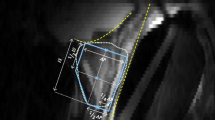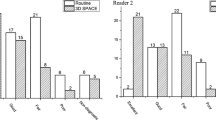Abstract
Introduction
Although several reports about volumetric determination of the pituitary gland exist, volumetries have been solely performed by indirect measurements or manual tracing on the gland’s boundaries. The purpose of this study was to evaluate the accuracy and reproducibility of a novel semi-automatic MR-based segmentation technique.
Methods
In an initial technical investigation, T1-weighted 3D native magnetised prepared rapid gradient echo sequences (1.5 T) with 1 mm isotropic voxel size achieved high reliability and were utilised in different in vitro and in vivo studies. The computer-assisted segmentation technique was based on an interactive watershed transform after resampling and gradient computation. Volumetry was performed by three observers with different software and neuroradiologic experiences, evaluating phantoms of known volume (0.3, 0.9 and 1.62 ml) and healthy subjects (26 to 38 years; overall 135 volumetries).
Results
High accuracy of the volumetry was shown by phantom analysis; measurement errors were <4% with a mean error of 2.2%. In vitro, reproducibility was also promising with intra-observer variability of 0.7% for observer 1 and 0.3% for observers 2 and 3; mean inter-observer variability was in vitro 1.2%. In vivo, scan–rescan, intra-observer and inter-observer variability showed mean values of 3.2%, 1.8% and 3.3%, respectively. Unifactorial analysis of variance demonstrated no significant differences between pituitary volumes for various MR scans or software calculations in the healthy study groups (p > 0.05).
Conclusion
The analysed semi-automatic MR volumetry of the pituitary gland is a valid, reliable and fast technique. Possible clinical applications are hyperplasia or atrophy of the gland in pathological circumstances either by a single assessment or by monitoring in follow-up studies.





Similar content being viewed by others
Abbreviations
- CT:
-
Computer tomography
- MRI:
-
Magnetic resonance imaging
- CAD:
-
Computer-assisted diagnosis
- SE:
-
Spin echo
- MPRAGE:
-
Magnetised prepared rapid gradient echo
- MPR:
-
Multiplanar reconstructed
- IWT:
-
Interactive watershed transform
- SD:
-
Standard deviation
- ME:
-
Measurement error
- CV:
-
Coefficient of variation
- SEM:
-
Standard error of the mean
- ANOVA:
-
Analysis of variance
- GE:
-
Gradient echo
- SNR:
-
Signal-to-noise ratio
References
Castillo M (2005) Pituitary gland: development, normal appearances, and magnetic resonance imaging protocols. Top Magn Reson Imaging 16:259–268. doi:10.1097/01.rmr.0000224682.91253.15
Rennert J, Doerfler A (2007) Imaging of sellar and parasellar lesions. Clin Neurol Neurosurg 109:111–124. doi:10.1016/j.clineuro.2006.11.001
Amar AP, Weiss MH (2003) Pituitary anatomy and physiology. Neurosurg Clin N Am 14:11–23
Sanno N, Teramoto A, Osamura RY, Horvath E, Kovacs K, Lloyd RV, Scheithauer BW (2003) Pathology of pituitary tumors. Neurosurg Clin N Am 14:25–39
Elster AD (1993) Modern imaging of the pituitary. Radiology 187:1–14
Syvertsen A, Haughton VM, Williams AL, Cusick JF (1979) The computed tomographic appearance of the normal pituitary gland and pituitary microadenomas. Radiology 133:385–391
Miki Y, Matsuo M, Nishizawa S, Kuroda Y, Keyaki A, Makita Y, Kawamura J (1990) Pituitary adenomas and normal pituitary tissue: enhancement patterns on gadopentetate-enhanced MR imaging. Radiology 177:35–38
Portman O, Flemming S, Cox JP, Johnston DG, Bydder GM (2008) Magnetic resonance imaging of the normal pituitary gland using ultrashort TE (UTE) pulse sequences (REV 1.0). Neuroradiology 50:213–220. doi:10.1007/s00234-007-0329-7
Miki Y, Kanagaki M, Takahashi JA, Ishizu K, Nakagawa M, Yamamoto A, Fushimi Y, Okada T, Mikuni N, Kikuta K, Hashimoto N, Togashi K (2007) Evaluation of pituitary macroadenomas with multidetector-row CT (MDCT): comparison with MR imaging. Neuroradiology 49:327–333. doi:10.1007/s00234-006-0194-9
Lurie SN, Doraiswamy PM, Husain MM, Boyko OB, Ellinwood EH Jr, Figiel GS, Krishnan KRR (1990) In vivo assessment of pituitary gland volume with magnetic resonance imaging: the effect of age. J Clin Endocrinol Metab 71:505–508. doi:10.1210/jcem-71-2-505
Marziali S, Gaudiello F, Bozzao A, Scirè G, Ferone E, Colangelo V, Simonetti A, Boscherini B, Floris R, Simonetti G (2004) Evaluation of anterior pituitary gland volume in childhood using three-dimensional MRI. Pediatr Radiol 34:547–551. doi:10.1007/s00247-004-1208-6
Takano K, Utsunomiya H, Ono H, Ohfu M, Okazaki M (1999) Normal development of the pituitary gland: assessment with three-dimensional MR volumetry. AJNR Am J Neuroradiol 20:312–315
Elster AD, Sanders TG, Vines FS, Chen MY (1991) Size and shape of the pituitary gland during pregnancy and post partum: measurement with MR imaging. Radiology 181:531–535
Miki Y, Kataoka ML, Shibata T, Haque TL, Kanagaki M, Shimono T, Okada T, Hiraga A, Nishizawa S, Ueda H, Rahman M, Konishi J (2005) The pituitary gland: changes on MR images during the 1st year after delivery. Radiology 235:999–1004. doi:10.1148/radiol.2353040243
Sharafuddin MJ, Luisiri A, Garibaldi LR, Fulk DL, Klein JB, Gillespie KN, Graviss ER (1994) MR imaging diagnosis of central precocious puberty: importance of changes in the shape and size of the pituitary gland. AJR Am J Roentgenol 162:1167–1173
McLachlan MS, Williams ED, Fortt RW, Doyle FH (1968) Estimation of pituitary gland dimensions from radiographs of the sella turcica. A post-mortem study. Br J Radiol 41:323–330
Peyster RG, Hoover ED, Viscarello RR, Moshang T, Haskin ME (1983) CT appearance of the adolescent and preadolescent pituitary gland. AJNR Am J Neuroradiol 4:411–414
Krishnan KR, Doraiswamy PM, Lurie SN, Figiel GS, Husain MM, Boyko OB, Ellinwood EH Jr, Nemeroff CB (1991) Pituitary size in depression. J Clin Endocrinol Metab 72:256–259. doi:10.1210/jcem-72-2-256
Schwartz PJ, Loe JA, Bash CN, Bove K, Turner EH, Frank JA, Wehr TA, Rosenthal NE (1997) Seasonality and pituitary volume. Psychiatry Res 74:151–157
Hahn HK, Peitgen HO (2003) IWT—interactive watershed transform: a hierarchical method for efficient interactive and automated segmentation of multidimensional gray-scale images. Proc Medical Imaging SPIE 5032:643–653
Hahn HK (2005) Morphological volumetry. Theory, concepts, and application to quantitative medical imaging. Dissertation, University of Bremen, Germany
Haris K, Efstratiadis SN, Maglaveras N, Katsaggelos AK (1998) Hybrid image segmentation using watersheds and fast region merging. IEEE Trans Image Process 7:1684–1699
Lukas C, Hahn HK, Bellenberg B, Rexilius J, Schmid G, Schimrigk SK, Przuntek H, Köster O, Peitgen HO (2004) Sensitivity and reproducibility of a new fast 3D segmentation technique for clinical MR-based brain volumetry in multiple sclerosis. Neuroradiology 46:906–915. doi:10.1007/s00234-004-1282-3
Hahn HK, Millar WS, Klinghammer O, Durkin MS, Tulipano PK, Peitgen HO (2004) A reliable and efficient method for cerebral ventricular volumetry in pediatric neuroimaging. Meth Inf Med 43:376–382
Giesel FL, Hahn HK, Thomann PA, Widjaja E, Wignall E, von Tengg-Kobligk H, Pantel J, Griffiths PD, Peitgen HO, Schroder J, Essig M (2006) Temporal horn index and volume of medial temporal lobe atrophy using a new semiautomated method for rapid and precise assessment. AJNR Am J Neuroradiol 27:1454–1458
Moul DE, Wehr TA, Frank JA (1995) Possible seasonal changes in pituitary size. AJNR Am J Neuroradiol 16:214–215
Mueller CA, Scorzin J, Koenig R, Urbach H, Fimmers R, Zentner J, Lehmann TN, Schramm J (2007) Comparison of manual tracing versus a semiautomatic radial measurement method in temporal lobe MRI volumetry for pharmacoresistant epilepsy. Neuroradiology 49:189–201. doi:10.1007/s00234-006-0171-3
Tae WS, Kim SS, Lee KU, Nam EC, Kim KW (2008) Validation of hippocampal volumes measured using a manual method and two automated methods (FreeSurfer and IBASPM) in chronic major depressive disorder. Neuroradiology 50:569–581. doi:10.1007/s00234-008-0383-9
Benesch H, Felber SR, Finkenstedt G, Kremser C, Stockhammer G, Aichner FT (1995) MR volumetry for monitoring intramuscular bromocriptine treatment in macroprolactinomas. J Comput Assist Tomogr 19:866–870
Van der Vlugt-Meijer RH, Meij BP, Voorhout G (2006) Thin-slice three-dimensional gradient-echo magnetic resonance imaging of the pituitary gland in healthy dogs. Am J Vet Res 67:1865–1872. doi:10.2460/ajvr.67.11.1865
Rao VM, Vinitski S, Babaria A, Flanders A, Mishkin MM, Gonzalez C (1991) Enhanced resolution of pituitary fossa by three-dimensional fat-suppressed gradient-echo magnetic resonance: before and after gadolinium enhancement. J Neuroimaging 1:95–99
Firbank MJ, Coulthard A, Harrison RM, Williams ED (1999) Partial volume effects in MRI studies of multiple sclerosis. Magn Reson Imaging 17:593–601. doi:10.1016/S0730-725X(98)00210-0
Ashton EA, Takahashi C, Berg MJ, Goodman A, Totterman S, Ekholm S (2003) Accuracy and reproducibility of manual and semiautomated quantification of MS lesions by MRI. J Magn Reson Imaging 17:300–308. doi:10.1002/jmri.10258
Joe BN, Fukui MB, Meltzer CC, Huang QS, Day RS, Greer PJ, Bozik ME (1999) Brain tumor volume measurement: comparison of manual and semiautomated methods. Radiology 212:811–816
Jack CR Jr, Bentley MD, Twomey CK, Zinsmeister AR (1990) MR imaging-based volume measurements of the hippocampal formation and anterior temporal lobe: validation studies. Radiology 176:205–209
Kiortsis D, Xydis V, Drougia AG, Argyropoulou PI, Andronikou S, Efremidis SC, Argyropoulou MI (2004) The height of the pituitary in preterm infants during the first 2 years of life: an MRI study. Neuroradiology 46:224–256. doi:10.1007/s00234-003-1126-6
Shimono T, Hatabu H, Kasagi K, Miki Y, Nishizawa S, Misaki T, Hiraga A, Konishi J (1999) Rapid progression of pituitary hyperplasia in humans with primary hypothyroidism: demonstration with MR imaging. Radiology 213:383–388
Doraiswamy PM, Krishnan KR, Figiel GS, Husain MM, Boyko OB, Rockwell WJ, Ellinwood EH Jr (1990) A brain magnetic resonance imaging study of pituitary gland morphology in anorexia nervosa and bulimia. Biol Psychiatry 28:110–116
Argyropoulou MI, Xydis V, Kiortsis DN, Pantou K, Zikou A, Efremidis SC, Andronikou S (2004) Pituitary gland signal in pre-term infants during the first year of life: an MRI study. Neuroradiology 46:1031–1035. doi:10.1007/s00234-004-1285-0
Pickett CA (2005) Update on the medical management of pituitary adenomas. Curr Neurol Neurosci Rep 5:178–185
Yoon PH, Kim DI, Jeon P, Lee SI, Lee SK, Kim SH (2001) Pituitary adenomas: early postoperative MR imaging after transsphenoidal resection. AJNR Am J Neuroradiol 22:1097–1104
Conflict of interest statement
We declare that we have no conflict of interest.
Author information
Authors and Affiliations
Corresponding author
Rights and permissions
About this article
Cite this article
Renz, D.M., Hahn, H.K., Schmidt, P. et al. Accuracy and reproducibility of a novel semi-automatic segmentation technique for MR volumetry of the pituitary gland. Neuroradiology 53, 233–244 (2011). https://doi.org/10.1007/s00234-010-0727-0
Received:
Accepted:
Published:
Issue Date:
DOI: https://doi.org/10.1007/s00234-010-0727-0




